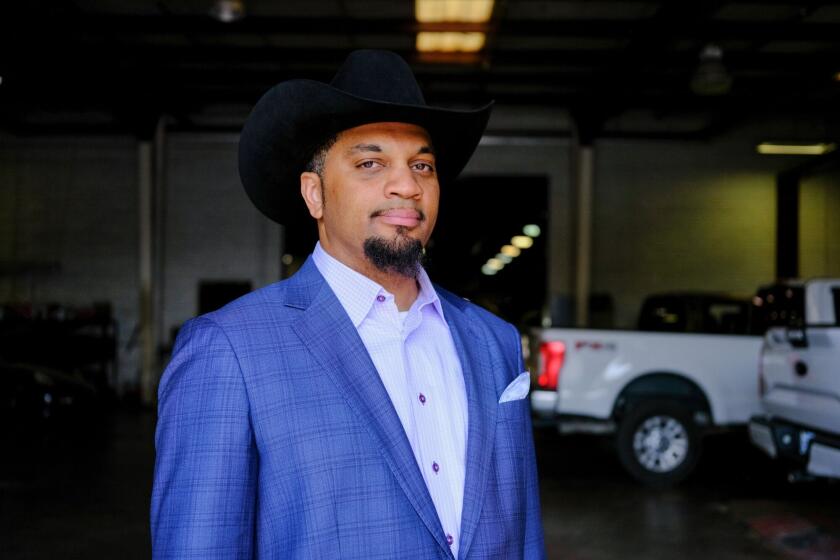Review: 2018 Honda Gold Wing is lighter, sportier, more powerful and better looking
- Share via
The mighty Gold Wing is arguably the most important motorcycle in Honda’s entire lineup.
Long the touring bike of choice for long riders who eschew the market-leading big twins built by Harley-Davidson and Indian Motorcycle, the Gold Wing has — since its U.S. arrival in 1975 — been rightly praised for its power, comfort and dependability.
The 2018 model represents the first Gold Wing overhaul in almost a decade. The sixth-generation machine is lighter, sportier and more powerful. It handles better and gets better fuel economy. It’s better looking.
So, why doesn’t everyone love it?
Like its predecessor Goldie, the 2018 is powered by an 1833cc, horizontally opposed six-cylinder engine that puts out a reported 97.8 horsepower and 108 pound-feet of torque. Power is delivered to the rear wheel via a shaft drive.
Wrapped around the engine is a superior touring machine. The plush, wide seats (standard height is 29.3 inches) are comfortable even after hours in the saddle. Wind protection provided by the electronically adjustable windscreen is first-rate. In its lowest position it reduces helmet noise and baffling to almost nothing. In its highest position, it creates an almost completely windless rider pocket.
Heated grips and seats (standard for both pilot and passenger) take the chill off the morning air. The backrest that also comes standard on the Tour model I rode was deemed the best in the business by my passenger, who is also my wife and favorite pillion choice, and whose previous favorite touring motorcycle was … the 2016 Honda Gold Wing.
The 2018 Wing is 85 pounds lighter than previous models. Honda managed to shave weight from the engine while also making it more efficient. The gas tank holds less fuel than the 2017 version, but better fuel economy means the bike still has the same long range: about 225 miles.
The lighter weight also gives the bike a more nimble, flickable feel, and may disabuse riders of the notion that the Gold Wing is what Honda’s on-road media director Colin Miller called “an old man couch on wheels.”
Over the course of a three-day spring break ride from Los Angeles to Borrego Springs and back, I found it just as capable running the mid-speed twisties of Montezuma Valley Road as it was on the high-speed straight line miles of Interstate 15.
New for 2018 is a reconfigured front suspension. Gone is the traditional telescoping shock, replaced by a “double wishbone” system, similar to the Duolever system on the larger-sized BMW touring bikes. Honda reports that reduces shock between the road and the rider by 30%. I can report that it results in marvelously fluid steering and impact absorption, at high speeds and low.
Power from the flat six comes on low and stays on. The Gold Wing chugs comfortably from a dead stop and spins up slowly. At 80 miles per hour, the engine was still turning below 3,000 rpm. The Gold Wing is configured with cruise control, so long-distance highway riding is a matter of set it and forget it.
And because it’s a liquid-cooled engine, unlike the air-cooled power plants on the Harleys, Indians and new Yamaha Star Ventures and Eluders, the Gold Wing produces no engine heat — a point of real consideration for Southern Californians who must often ride in warm weather.
The model I rode was fitted with Honda’s DCT automatic seven-speed transmission, a feature that I had previously explored on the company’s smaller NC700 touring bike. As on that machine, I found it smooth, seamless and intuitive. Although I was not persuaded to give up the clutch-and-shift-lever system found on most bikes (the six-speed manual transmission is standard at a slightly lower cost on the Gold Wing), I was able to understand why some riders would prefer it.
The 2018 also features substantially upgraded electronics and infotainment, bringing it solidly in line with what’s being offered by the top touring motorcycles on the market. Indeed, it is so electronically sophisticated that, after several weeks with the Gold Wing, I was still discovering its less obvious qualities.
The music system (featuring front and rear speakers on the Tour model) poured forth high-quality sound. Though I prefer music through a headset when I ride, when I listen to music at all, I did appreciate the stirring strands of Beethoven’s Symphony No. 7 as we were cresting Banner Grade and arriving in Julian.
I also had occasion to appreciate the Gold Wing’s ingenious “walking gear” feature, standard on all the DCT models.
Stopping for refreshments in Moreno Valley, I unthinkingly left the bike pointed slightly downhill in a sloping parking space. Even at 85 pounds lighter, the Gold Wing is still a beast — close to 800 pounds when fully fueled. So moving it around can require a lot of muscle.
But by engaging the walking gear, I was easily able to shift the bike into “reverse” and slowly crawl out of the parking place and back onto level ground before resuming the ride.
Reviews for the 2018 Gold Wing have been universally positive. And those reviews and many prospective riders with whom I’ve spoken voiced universal concern over the Gold Wing’s one weak point: storage.
The new model offers its owner 110 liters of storage space — down from 150 on the 2017 Wing. Even though most Gold Wing customers will use their bikes for long-distance touring, that figure may not present a problem.
But because most Gold Wing operators tend to do their touring two-up, this fact will: The hard-sided saddle bags will not accommodate a full-size helmet, and the trunk won’t accommodate two.
Honda did include a helmet lock system, integrated into the left side saddlebag, that Honda communications officer Jon Seidel said would allow two helmets to be locked and stored on top of the bike, but not hidden from view. But maybe they won’t be couples. It could be that the new-generation Gold Wing will attract a new kind of rider.
That’s because the new Gold Wing isn’t the same old touring bike. Some who’ve ridden it say it feels more like BMW’s K1600GTL than an earlier Gold Wing, while others have said it’s less similar to that Goldie than to Honda’s earlier ST1000 — the sport touring bike that the company built and sold in the U.S. from 2003 to 2009.
“The intent from the designers was to make it more sporty, capable of being a touring bike but also great if you were looking to sport tour and ride in the canyons every day,” Seidel said.
The purpose of that: “to bring down the median age” of the Gold Wing customer, Seidel said, to include “that 40s person who would never have considered buying a Gold Wing before.”
A rider who gets on the new Wing, selects Sport mode and pushes the bike through some corners might forget all about not being able to store a second helmet.
That rider will still need to bring plenty of wallet. The stripped-down Gold Wing starts at $23,500, and the Tour model with DCT starts at $27,700.





